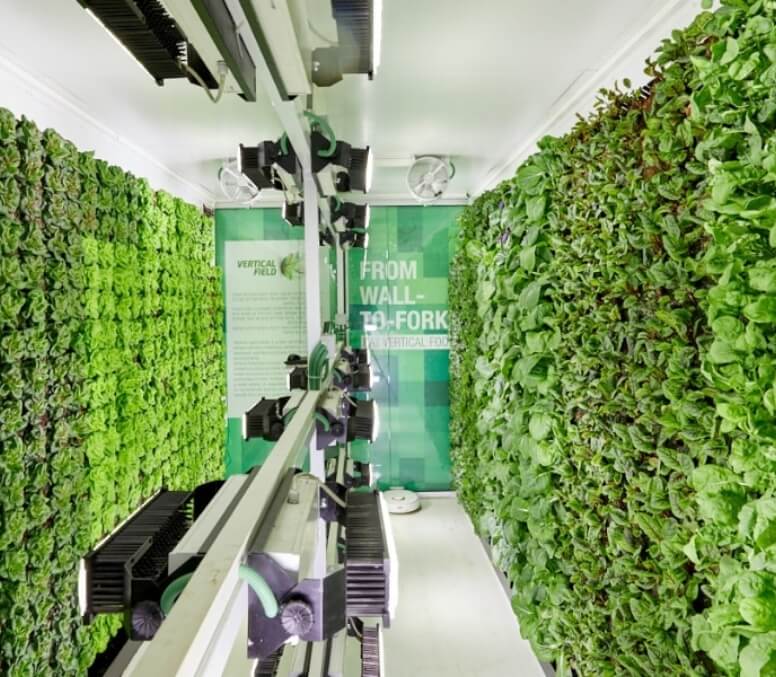What is commercial vertical farming?
From warehouses to shipping containers, commercial vertical farming practices are reshaping the agricultural supply chain.
Vertical farming is an agricultural method that utilizes vertical space to grow produce. Commercial vertical farming therefore is a business-oriented method of agriculture, where crops are grown vertically for commercial purposes, such as wholesale and retail. Whereas conventional commercial agriculture uses large swaths of land to grow produce horizontally, commercial vertical farming uses height and stacked layers to grow crops on top of each other, thus enhancing the local food movement via efficient use of space. Typical agriculture technologies that are used in vertical farming include hydroponic (water-based), aeroponic (mist-based), and geoponic (soil-based) systems, where hydroponic systems make up most of the market share.

Why is commercial vertical farming beneficial?
There are many advantages to commercial vertical farming techniques. Growing produce indoors with controlled-environment agriculture increases the reliability and consistency of produce. Since all inputs are carefully measured, distributed, and monitored, and because produce is not subject to the volatility of outside weather patterns, output is consistent, thus ensuring food security year-round.
Vertical farming also uses significantly less resources than conventional field-grown agriculture. In fact, on average, vertical farms use over 90% less water and land than traditional outdoor methods. Precision farming means less waste, less spoilage, and more efficient farming techniques.
The efficient use of space with vertical farming essentially enables crops to be grown in densely populated areas, such as cities, meaning the consumer is right around the corner.
Furthermore, because commercial vertical farming takes place indoors, most producers grow crops without the use of chemical pesticides, a major advantage to field-grown agriculture.
How does commercial vertical farming affect the agrifood supply chain?
Most commercial vertical farming initiatives implement a modified supply chain that is much shorter than the conventional agricultural supply chain. To understand the benefits, let’s dive into what the typical supply chain looks like for the agricultural industry.
The conventional agricultural supply chain involves a number of lengthy processes, each stage laden with logistics and dynamic variables. The process typically includes: growing and harvesting crops on a farm, moving them to processing plants and other intermediary silos, then to distributors who move them to wholesale markets, and eventually they reach the retailer and the consumer. Produce that travels internationally must also go through customs. (In the United States, 30% of produce is imported internationally.)
The agrifood supply chain varies slightly depending on the country, region, and food product, and can include other stops along the way, such as storage plants and secondary processing facilities.
This process is therefore expensive, time-consuming, unsustainable, dangerous, and can be erratic, as it is dependent on many dynamic and interconnected elements. Let’s break it down.
Expensive: Major costs of the agrifood supply chain include transportation, processing, procurement, operation, refrigeration, storage, and food losses. Logistics to ensure that the flow of produce moves fluidly throughout these stages is another major cost as proper coordination is necessary at each stage among various players in the field.
Distance and Time: According to a study conducted by the Leopold Center for Sustainable Agriculture, lettuce in Chicago travels approximately 2,000 miles before reaching the supermarket, apples about 1,500 miles, peaches 1,600 miles, and so forth. Depending on the product, produce travels by air, ship, or truck, (with 60% traveling by ship and 30% by road) – and can take anywhere from days to weeks before reaching the supermarket shelf. To account for such delays, produce is sometimes harvested before it is ripened, and is then gassed after transport to ripen it (which affects the taste, quality, and shelf-life).
Dangerous: The climate crisis and COVID pandemic have illustrated how complexities within the supply chain can threaten the flow of important goods in times of crisis due to unforeseen infrastructural or logistical disruptions along the way. Since the supply chain is, in face, a chain, when one element stops flowing at any stage of the product’s development, it prevents the entire product from reaching the consumer. Another risk that lengthy agrifood supply chains pose are food contaminants.
Erratic: Since components in a supply chain are all interdependent upon each other, the moment there is a disruption in one aspect it affects the entire flow of goods. For example, during the COVID crisis, machine parts were unable to leave Asia in a timely manner, which prevented farmers from preparing and expanding their fields, and thus limited the production and distribution of a number of food products. Labor shortages have also frequently affected the agrifood supply chain over the past several years.
Unsustainable:
The globalized agrifood supply chain is also problematic from an environmental perspective due to food losses, transportation, and refrigeration, which contribute significantly to greenhouse gas emissions. In fact, food contributes to approximately 30% of all global greenhouse gas emissions.
On-site vertical farming and other urban farming methods can circumvent much of the supply chain by growing produce at or near the point of consumption, thus increasing food security and building resilient food systems.
Using agriculture technology, such as controlled-environment agriculture to develop indoor vertical farming techniques, produce can be grown anywhere, minimizing the need for stages such as processing and distribution.
One of the most popular technologies being implemented in the field of commercial vertical farming is hydroponic agricultural systems, which are often placed inside of warehouses near the city. While such models can reduce the supply chain, thus expediting some elements of the process, they do not completely eliminate the supply chain, and still rely on several stages such as transportation, processing, and others.
Some companies, such as Vertical Field, which uses a geoponic system, takes local farming to the next level by growing produce adjacent to supermarkets and restaurants, and therefore completely circumventing the supply chain. By bringing the farm closer to the consumer, produce is fresher, healthier, and more reliable.
Commercial vertical farming proposes a supplementary source of produce, and enables supermarkets to receive local produce without the uncertainties and logistics that surround large-scale, field-grown crops. The vertical farming market size was valued at $3.1 billion in 2021, and is expected to reach $9.7 billion by 2026 as projects expand throughout the world.
Want to Learn More? Click Here For Our Real Knowledge Page.
FAQ
Vertical farming can be implemented in any country or city. As most vertical farming operations use indoor controlled-environment agriculture, the outdoor conditions such as soil quality, rainfall, seasons, climate, and topography are not barriers to growing crops.
Indoor vertical farming ensures a steady and reliable output of yield. So while indoor vertical farming can be employed anywhere in the world, countries that suffer from particularly extreme weather events or conditions (such as arid/freezing regions) can particularly benefit from the unique advantages of vertical farming.
As a niche industry, one of the challenges of vertical farming is transitioning from small-scale deployment to commercialization. Furthermore, technological features are developing in tandem; as these features enter the market they will increase the accessibility and affordability of vertical farming.
There are a number of vertical farming companies on the market that one could invest in. The vertical farming market size has been steadily growing, reaching approximately $3.24 billion in 2020 and expected to reach $24.11 billion by 2030, according to Allied Market Research.



